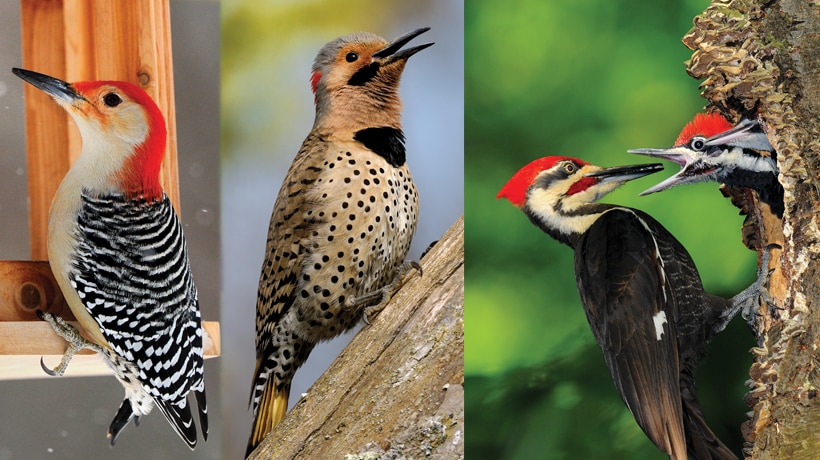Woodpeckers in Florida Populace: Types Introduction and Conservation
Woodpeckers in Florida Populace: Types Introduction and Conservation
Blog Article
Discover the Remarkable Globe of Woodpeckers: Everything You Required to Know
The globe of woodpeckers is a world full of unique actions, complex adaptations, and a diverse variety of varieties. From their habitats and distribution patterns to their feeding practices and specialized physiological features, woodpeckers have long astounded the interest of ornithologists and nature lovers alike. Recognizing the intricacies of these fascinating birds offers a glance right into the complicated interaction between their biology and the environment. As we explore the globe of woodpeckers additionally, we reveal a riches of details that clarifies their value in communities and the difficulties they deal with in an ever-changing world.
Woodpecker Habitats and Distribution
In North America, for instance, woodpeckers can be found in both coniferous and deciduous forests, utilizing their strong beaks to forage for bugs and produce nesting cavities in trees. In Africa, particular woodpecker varieties have actually adapted to arid atmospheres, such as the acacia woodlands, where they play an essential function in managing insect populations.

Feeding Behaviors and Diet
Amongst the different aspects of their behavior, woodpeckers exhibit distinctive feeding behaviors and nutritional preferences. These birds are mostly insectivores, with a diet plan that includes ants, beetles, caterpillars, and other pests found in trees. Woodpeckers use their strong beaks to drill into the bark of trees, probing for insects and larvae concealed beneath the surface area. In enhancement to bugs, woodpeckers additionally take in nuts, seeds, fruits, and sap. Some species have specialized tongues with barbed tips that assist them extract bugs from gaps in wood.
Woodpeckers are known for their drumming habits, which offers not only to communicate with various other woodpeckers yet likewise to find food. The fast drumming noise is created by the bird pecking on resonant surface areas like dead trees or metal posts. This behavior can bring in bugs hidden in the wood, enabling the woodpecker to discover their visibility and eat them.
Unique Adaptations for Tree Climbing
In their proficient search of bugs concealed within tree bark, woodpeckers have progressed amazing anatomical features that equip them with special adaptations for reliable tree climbing. Among the essential adjustments is their zygodactyl feet, with 2 toes directing onward and 2 pointing backward, supplying a solid hold on tree trunks. This customized foot plan allows woodpeckers to stick to vertical surface areas effortlessly, allowing them to go up and down trees with dexterity. In addition, woodpeckers have stiff tail plumes that function as a helpful prop while they climb up, aiding in equilibrium and stability. Their solid, chisel-like beaks are not just made use of for boring into wood however also for gripping onto bark as they rise tree trunks. In addition, woodpeckers have solid neck muscles and a special head structure that take in the effect of continuous pecking, enabling them to climb vertically without creating harm to their minds. These adaptations showcase the incredible transformative style that enables woodpeckers to browse trees with accuracy click here now and performance.
Diverse Woodpecker Types Worldwide
With over 200 different types spread out across numerous environments worldwide, the household of Picidae encompasses a remarkable variety of woodpeckers. These birds can be discovered in forests, forests, savannas, and also urban locations, showcasing their versatility to different atmospheres. From the legendary Northern Flicker in North America to the colorful and evasive Crimson-backed Flameback in Asia, each woodpecker types displays one-of-a-kind qualities in terms of plumage, behavior, and environment preference.
Woodpeckers differ significantly in size, with the small Downy Woodpecker gauging around 6-7 click over here inches in size, while the powerful Lineated Woodpecker can get to up to 17 inches - Woodpeckers in Florida. Their beaks likewise can be found in different shapes and sizes, mirroring their feeding practices. Some varieties specialize in removing pests from tree bark, like the Acorn Woodpecker, while others, such as the Black-cheeked Woodpecker, prey on fruits and seeds

Conservation Initiatives and Challenges
Preservation efforts for woodpecker populaces are crucial in minimizing the influence of environment loss and various other threats encountering these varied bird varieties. Woodpeckers deal with numerous difficulties to their survival, primarily as a result of logging, urbanization, environment modification, and invasive varieties. To attend to these issues, preservation efforts concentrate on protecting and recovering woodpecker habitats, executing lasting forestry techniques, and increasing recognition about the importance of these birds in communities.
One significant obstacle in woodpecker preservation is the fragmentation of their habitats, bring about separated populaces that are extra prone to extinction - Woodpeckers in Florida. Preservationists work to develop wildlife passages and shielded areas article that link these fragmented habitats, permitting woodpeckers to relocate between different areas for feeding, reproducing, and shelter

Conclusion
In verdict, woodpeckers are fascinating birds with unique adaptations for tree climbing and feeding actions. Additional research study and conservation activities are required to ensure the survival of woodpeckers in the wild.
Report this page